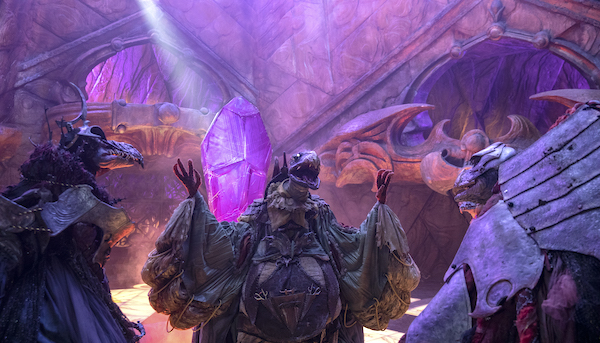Jeffrey Addiss and Will Matthews originally contacted the Jim Henson company to pitch a sequel idea for Labyrinth, and while the idea wasn’t in the cards even for a pitch meeting, they were invited to come up with an idea for Dark Crystal. “I grew up loving Dark Crystal. I grew up loving Henson,” said Addiss. “I had the VHS copy and it was something I watched over and over again.” The Henson company provided a lot of details for the prequel, but also gave the writers “space to create.”
“We wrote for everybody, but that’s pretty hard to do,” said co-screenwriter Will Matthews. “Our perspective was sort of represented by me and Jeff, where Jeff is the hardcore, long-term fan, and I am a fan. I was more of a Labyrinth fan than a Dark Crystal fan, because it scared me as a kid. Within the two of us, the dichotomy is represented, of those who are true believers and those new to the property.”
“You want to get the details right for the fans,” concluded Matthews, “But you don’t want to include so many that you overwhelm new audiences. The goal is to invite people into this rich world, not hand them homework to do before they can have fun.” This also meant having a balanced TV writers’ room of true believers and new fans.

Jeffrey Addiss
“You can even see [this dichotomy] in what we talked about when we designed our heroes of the story. We have three heroes who are all facing what they don’t realize yet is one central problem. There are 30 years of history, so it’s inherently complex. These things used to be one thing, but they split after they cracked this Crystal.”
Like the original script for Alien, the writers wanted something for viewers to connect with – structures. “Each of these characters should view the problem from a different angle, but also each character is from a different station in the world. Deet is the lowest. Rian is the company man. And, Brea is royalty. We’re introducing three problems, but also the world through three structures.”
Introducing the Dark Crystal World
With so much to explain about the Dark Crystal world, the screenwriters arguably spent the most time creating the first few minutes of the TV series. Like the iconic Star Wars opening crawl, their voiceover-led montage needed to summarize the world in an exciting, yet informative manner. “The first five minutes are by far the thing we wrote and rewrote the most, more so even than the battle at the end.”
Addiss said, “It was the most difficult because you have an extraordinary amount of world to set up. Thank goodness we had Director Louis Leterrier (Transporter, The Incredible Hulk), but I think the opening narration was the last thing that we locked. Right up to the end, we were tweaking it.”
Matthews said, “Even then, when we locked it, we locked more than one version. It was the most important, the most contentious, the highest stakes, because it was the beginning. There was a lot of talk about how much lore to include and how to do that visually as well.”
In the TV writers’ room, the director told his team the opening would undoubtedly be the hardest thing to work on and the aspect worked on last. “Three years later, he was right.”
When pre-production began, the writers had the ten scripts pretty much finished, but the difficult part in a Henson project is that worlds, or sets, are being physically built during the writing process.
“That had to happen simultaneously.” This is also true for creating creatures, where conceptual designer Brian Froud was sketching characters.
The World Building Process
In most screenplays, everyone has their own take for the story, but beyond screenwriter, director, and actor views, the world of puppets is drastically more complex (you can see more details in the making-of special, The Crystal Calls Making the Dark Crystal: Age of Resistance).
“The good news about Dark Crystal is that you have so many geniuses working on the same show at once. It takes a lot of people and it’s more intensive, but because of the love and reputation of the property, all of the chefs in the kitchen are five star Michelin folks, so you listen to them.”
In one example, the writers wanted a Mystic to shoot a bow and arrow. Simple enough. But, what this means in this world deciding not only how a four-armed creature shoots a bow, but choosing between six different types of bow and arrow, where the question was asked: “What is a bow, really?” Matthews added, “I just said bow and arrow, and this guy is writing poetry.”
“Then once you get on set, the puppeteers are rehearsing and you look at different ways to approach it. They’re having to figure out how to make it work, especially with a Mystic shooting a bow, which is really hard on the performers. But, at some point, it’s the evolution of the process.”

Will Matthews
Despite complications, it’s rare to ever hear a “No.” Instead, they discuss how to do something physically possible for the puppeteer. “When you do hit a wall and something seems impossible – like the carriage chase – Louie comes in and says, ’No, no, no, here is how you get over that wall.’ That’s an impossible sequence, but Louie never doubted it could be done and so, it was done.”
Outside of puppet logistics, this world is also much bigger than the original. The original movie used around 30 sets, where this new series uses closer to 90 sets, on raised platforms. As opposed to the green screens many production teams are used to, the writers said it was unique to see the old school wooden sets. “It’s tangible. It’s built. It’s gorgeous.”
“We do try to reuse sets at places where they could be reused, but there are some sets, like in Episode 7 (“Time to Make… My Move”) when we get to the Circle of the Suns, where you really only use that set for one episode, so you won’t see it again after that.”
Writing the Dark Crystal
Beyond the opening narration, the writers said Episode 5’s “She Knows All the Secrets” was difficult, but it changed forms during the episode. “All of our heroes came together, split up for the back half, then came back together for 10 (“A Single Piece Was Lost”), so 5 and 10 were the choke points,” said Addiss.
“A lot of plot was going to happen, so there were versions that were straight-up farce because how they were going to get there kept shifting. We had everyone running around the castle, like an episode of Frasier,” he joked.
Some aspects, such as the scientists, were written separately so they could be made easier to shoot. “We needed those cutaways because the battle was so time-consuming. It was a lot of balancing and we were lucky to have such an amazing TV writers’ room.”
Since neither of the creators had ever run a TV writers’ room before, they also looked to veteran writer Javier Grillo-Marxuach (Lost, Charmed) for assistance with the room itself. “Having Javy there was life-changing. We were extraordinarily lucky, but it was the hardest thing we’d ever done.”
Another writer in the room was YA author J.M. Lee, who wrote Episode 2’s “Nothing is Simple Anymore.” Addiss said, “You had to find moments where you could bend the book without breaking it if what we needed to do in the TV show was fundamentally different than what needed to happen in the novel series. You had to weave all of this together.”
In addition to the various complications of creating a Henson world, the screenwriters also faced location difficulties, as Addiss lived in London for one full year during the process.
Creating the Bones
As for writerly advice, the screenwriting duo recommends that you “lead with love.” Matthews said, “When you’re doing a fan property, you have to come as a fan first, but that’s only the start. Then, you have to build something new, including all the pieces you’re given. So the balance of honoring what’s come before and striking out in a new direction is the tightrope, but if you can walk it, you can have a show.”
“Just the idea that there is such a long process is freeing for the writing,” said Matthews, “because the draft is not the final draft. In fact, it’s nowhere near the final draft. In a way, you could say that road is so long it’s daunting, or you can say that road is so long it’s freeing. There are a lot of opportunities to make this thing better.”
“Knowing where you are in the process can inform the writing in a way that isn’t cynical or limiting – it’s encouraging. In the beginning, you’re writing for yourself, then you’re attaching a director or star. Then, you’re writing for a budget. That doesn’t make things worse, it makes things more specific. I think appreciating just how long the process frees you up from worrying about having to get everything exact and perfect on the first draft. It’s going to change – let it change.”
Addis concluded, “Make sure the bones of whatever you are doing are so strong. Make sure you can bend those bones, jump on them, and rearrange them so they don’t break because they will carry you through everything. We can change the nose or swap out the eye. How a character gets from Point A to Point B can change, but we have to know why they have to get to Point B, because of what that means emotionally. That’s the bones. That’s the arc. That’s the story.”
This interview has been condensed. Listen to the full interview here. Also, listen to another interview about the making of Dark Crystal with Director Louis Leterrier here.

